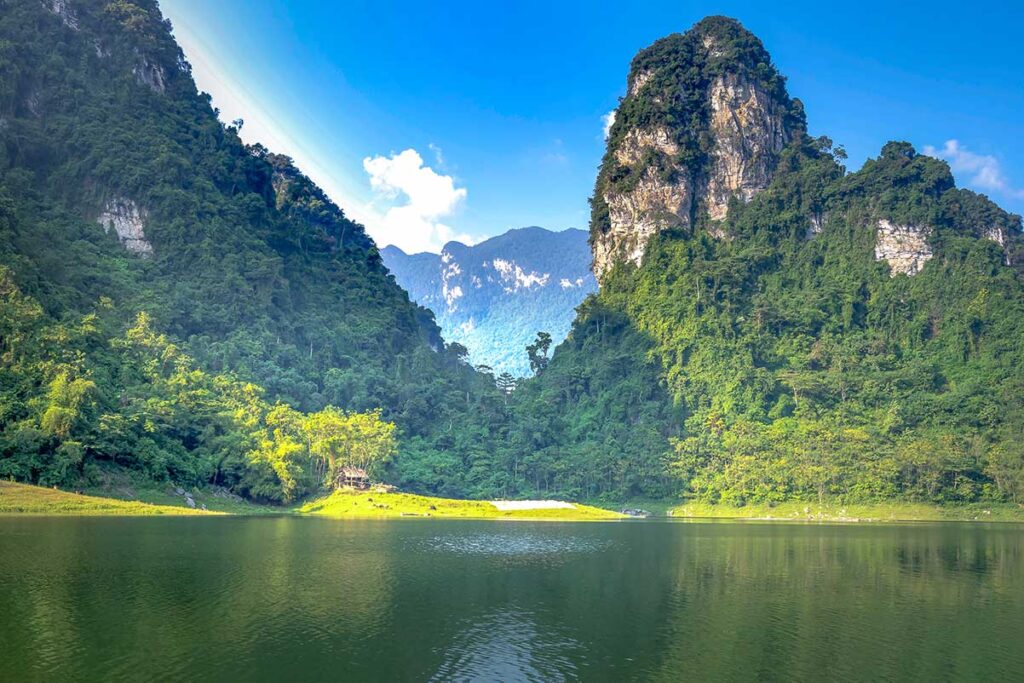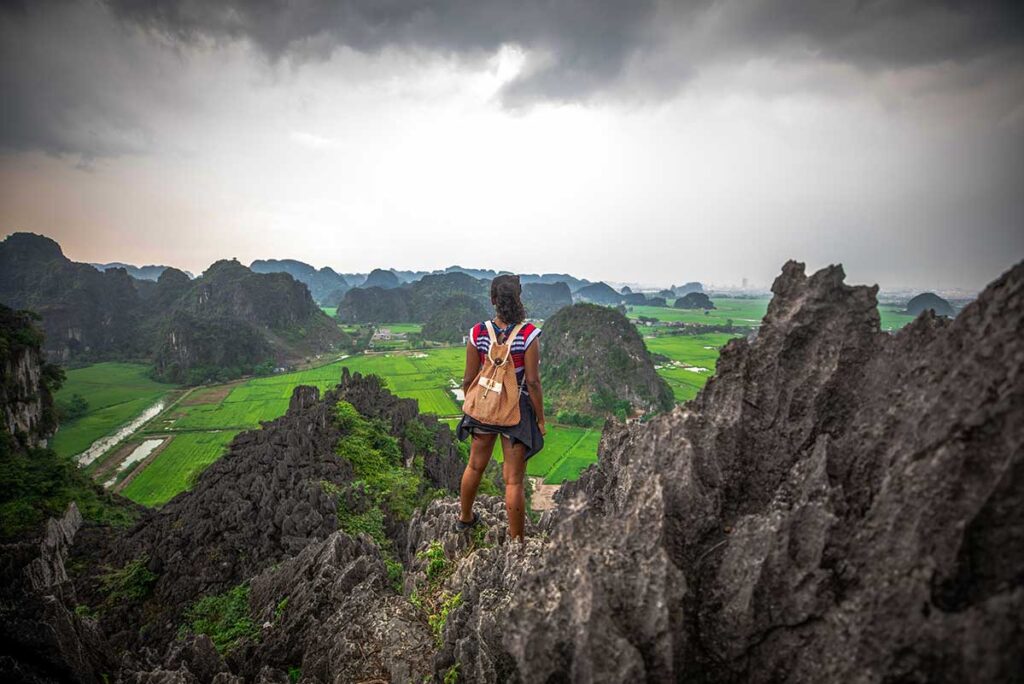About Na Hang
Na Hang is a remote and mountainous region located in northern Tuyen Quang province, where two rivers — the Gam and the Nang — meet to form a large, peaceful lake. Surrounded by limestone peaks, deep forests, and scattered ethnic minority villages, the area is known for its wild landscapes and slow pace of life. Despite its size and natural beauty, it remains mostly untouched by tourism.
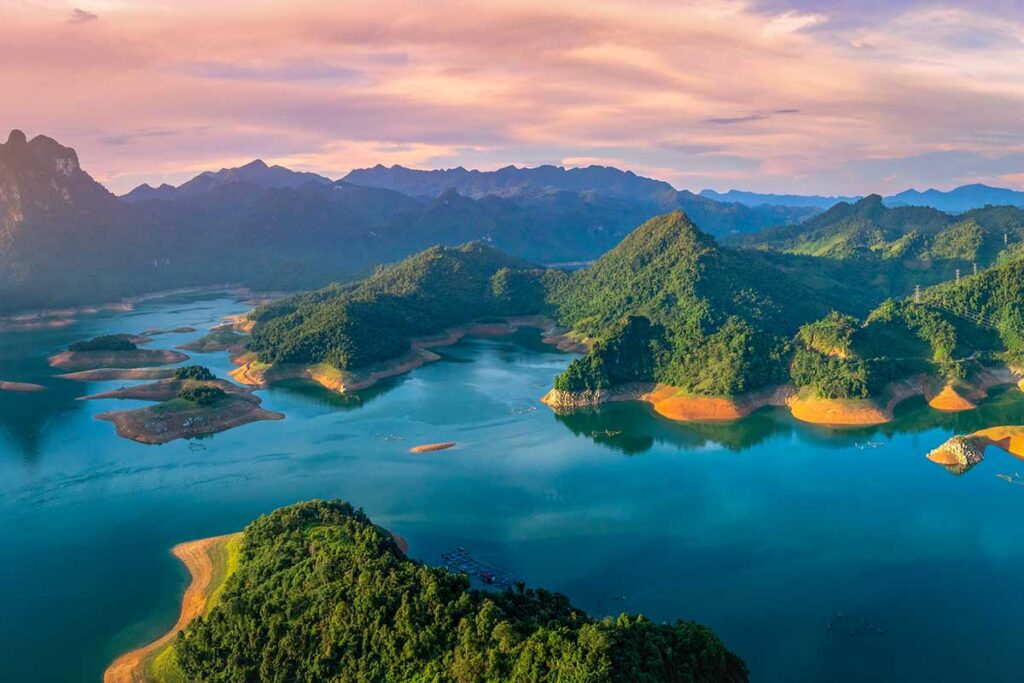
The name “Na Hang” comes from the Tay language and means “the last field” — a fitting name for a place that feels like it’s at the edge of the world. It’s home to more than ten different ethnic groups, including the Tay, Dao, and H’mong, each contributing to the area’s rich cultural traditions and stories. The land here is filled with myths, legends, and sacred sites that give it both a spiritual and mysterious character.
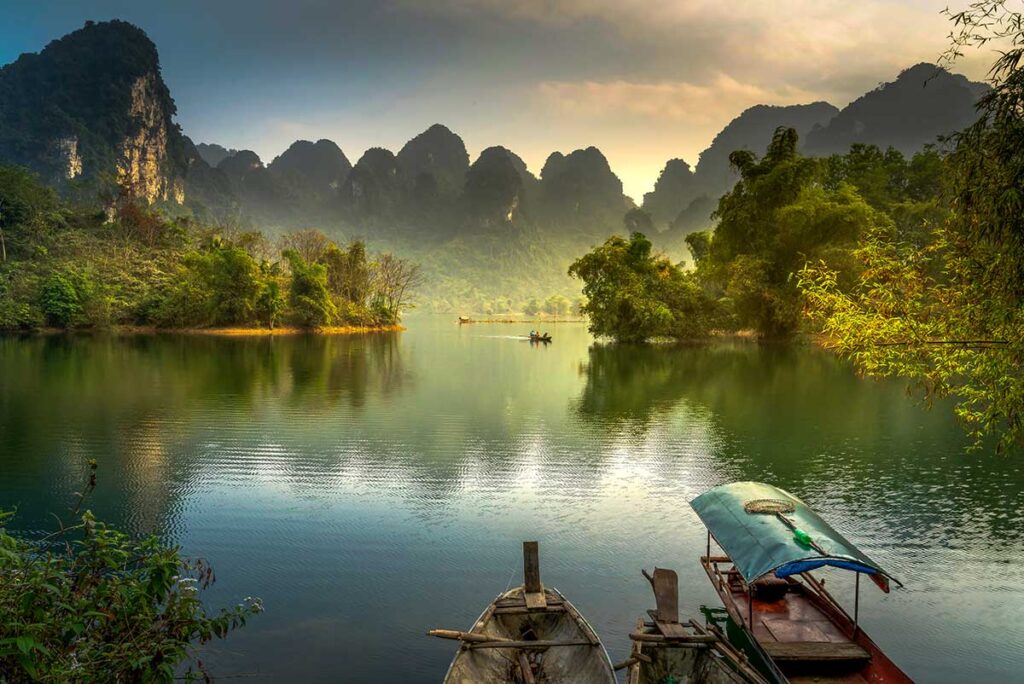
Much of the area now surrounds a large hydropower reservoir, but its natural charm hasn’t been lost. Locals often compare Na Hang to “Ha Long Bay on the mountains” — not because of towering cliffs rising from the sea, but because of the striking combination of water, stone, and sky that defines its scenery.
Things to do and see in Na Hang
1. Boat Ride on Na Hang Lake
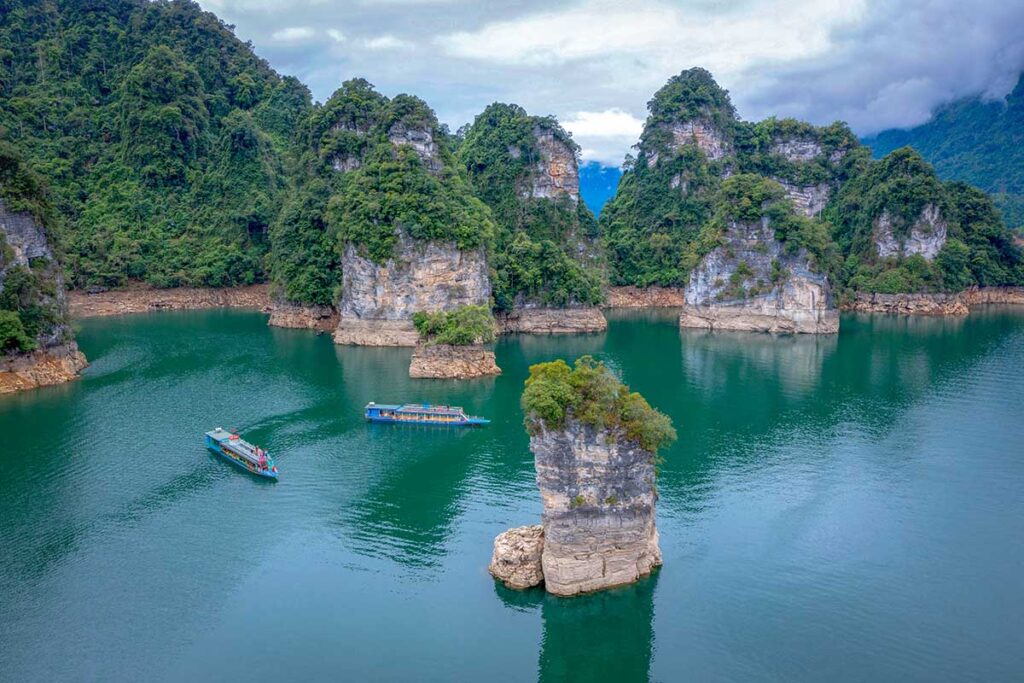
The centerpiece of Na Hang is its vast, scenic lake — formed by the confluence of the Gâm and Năng rivers. Surrounded by steep limestone peaks and forested hills, the lake stretches over 8,000 hectares and is often compared to a mountainous version of Ha Long Bay. The best way to experience it is by boat, slowly gliding past cliffs, caves, and hidden coves.
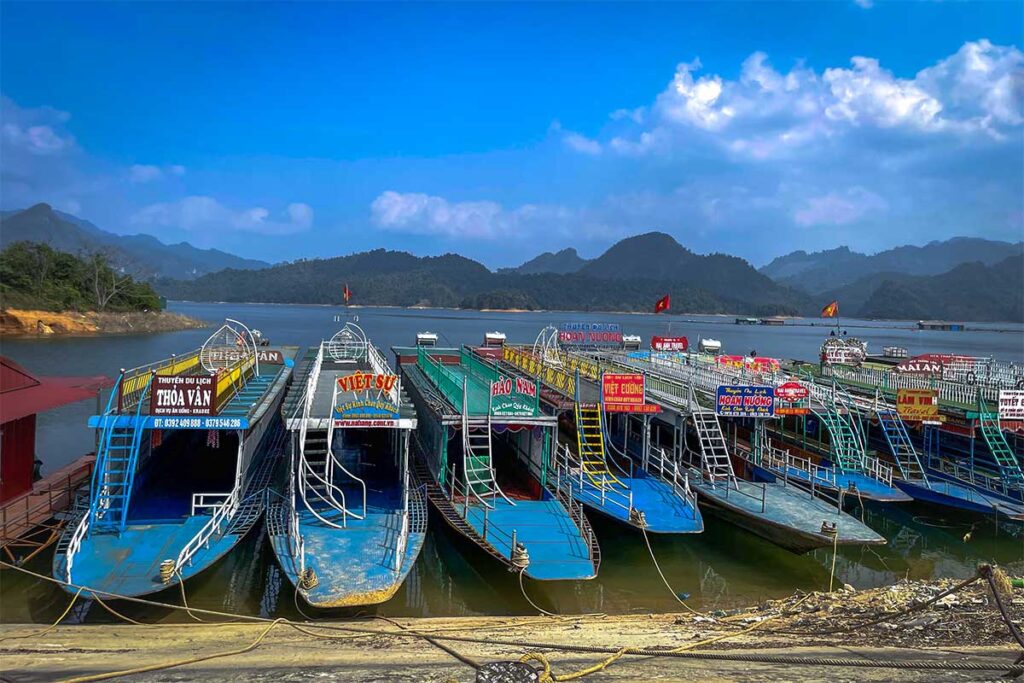
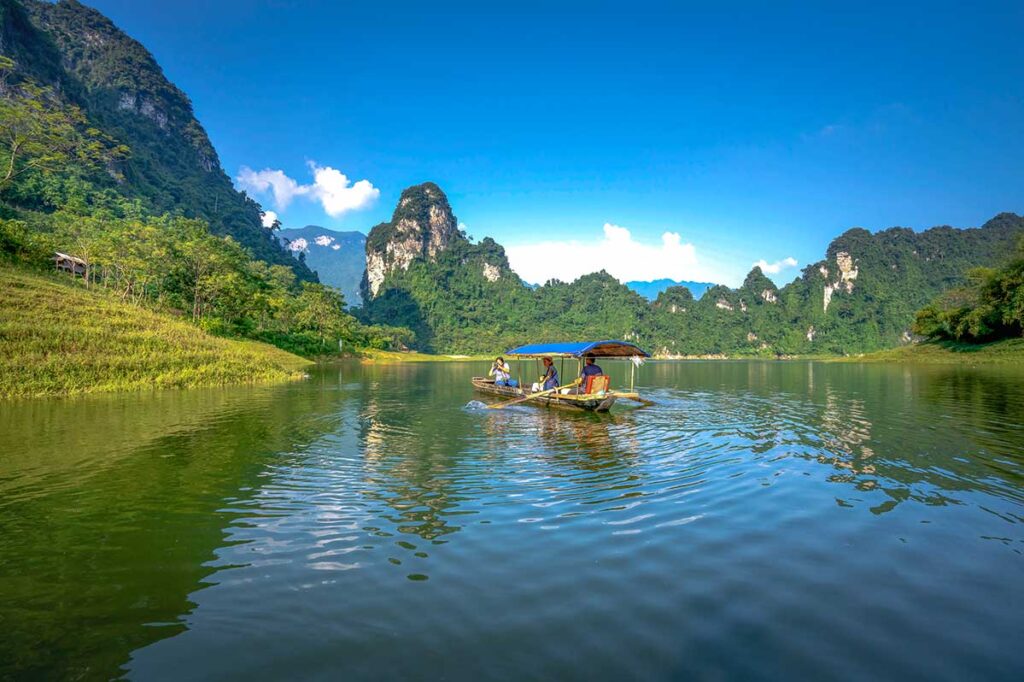
Boat tours depart from either Thuy Na Hang wharf (in town) or Thuy Thuong Lam wharf, and can be arranged through local hotels or at the dock. Prices range from 1,000,000 to 1,800,000 VND for a full boat (around $40–75 USD, depending on size and season). Tours usually take 3 to 4 hours, and include scenic stops at places like Khuoi Nhi Waterfall, Khuoi Gun Waterfall, Coc Vai rock pillar, and Song Long Cave. If you’re in a group, this is a relaxed and rewarding way to see the best of Na Hang’s natural scenery.
2. Walk through the Hong Thai terraced fields
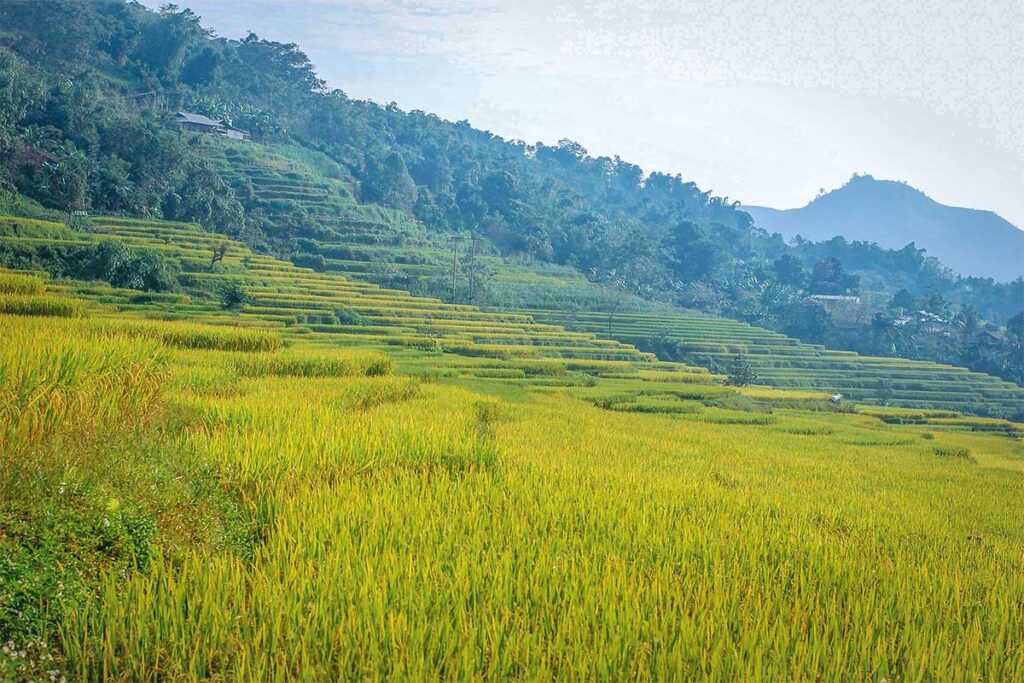
Hong Thai commune sits at around 1,000 meters above sea level and offers cool weather year-round, often earning it the nickname “mini Sapa of Tuyen Quang.” It’s best known for its terraced rice fields, which shine bright green during the growing season and turn golden yellow during the rice harvest (usually May–June and September–October).
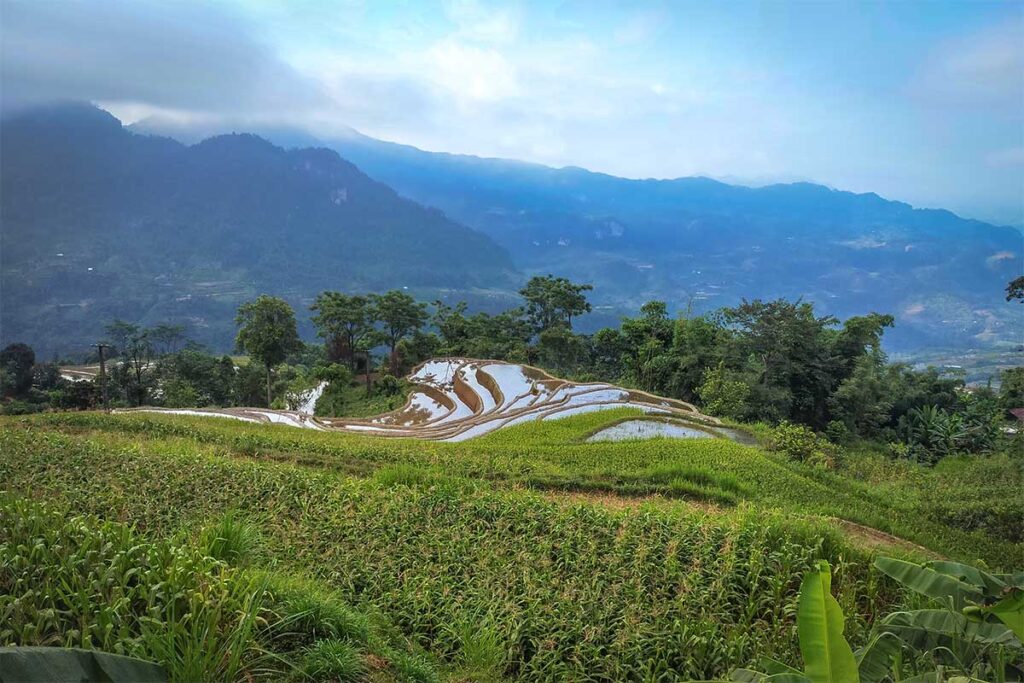
You won’t find easy trekking trails like in Sapa, but you can still walk peaceful countryside paths between fields and villages. It’s ideal for travelers who enjoy a slow pace and photography. There’s even a coffee shop with a panoramic view for those who prefer to relax. Pear blossom season (February–March) is another beautiful time to visit, with white blooms scattered across the hillsides.
3. Swim at Khuoi Nhi Waterfall
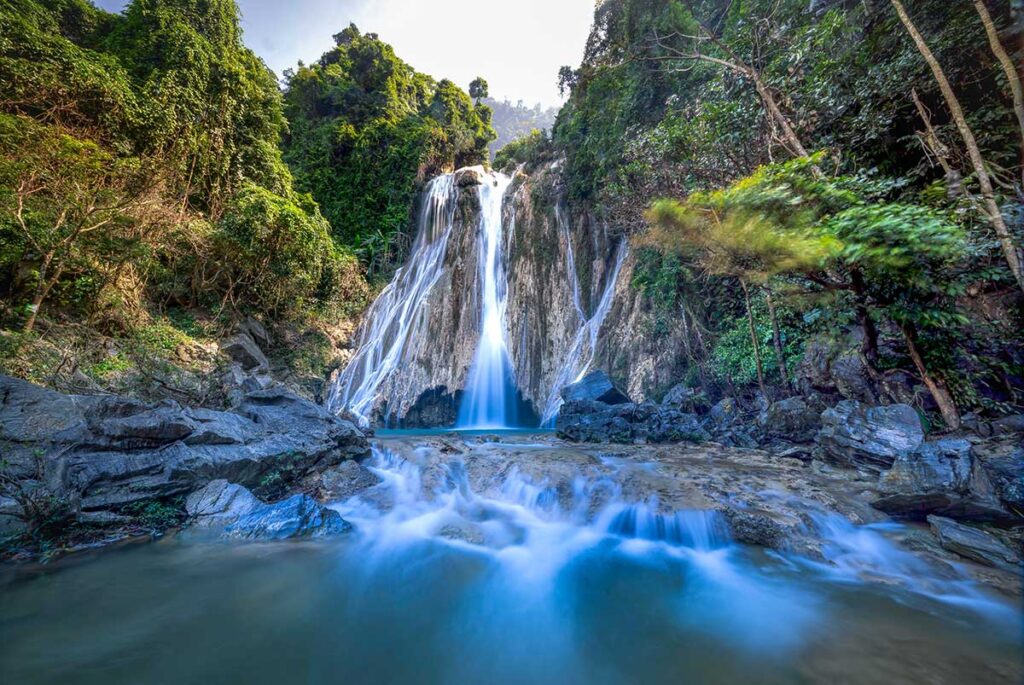
Khuoi Nhi Waterfall is one of the most popular stops along the Na Hang boat tour — and for good reason. This multi-level waterfall tumbles down through jungle cliffs into clear, swimmable pools below. The water is clean, cool, and surprisingly blue, especially during the dry months.
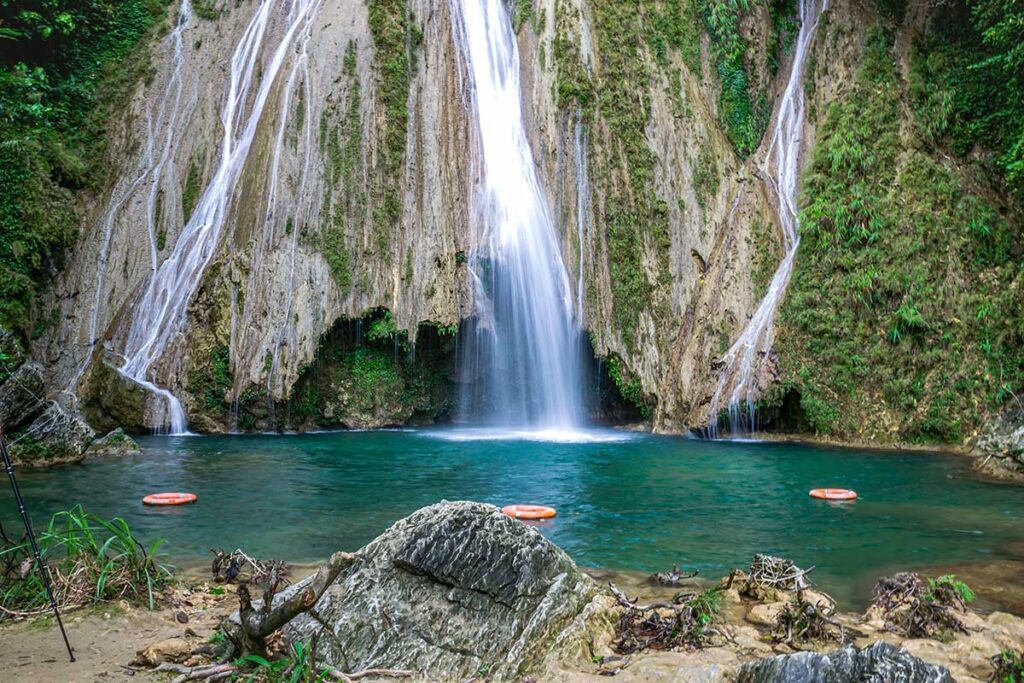
You’ll need to walk uphill a few hundred meters from the boat landing (watch your step — it can be slippery). Once there, you can swim under the cascades, dip your feet in for a natural fish massage, or even explore a small cave hidden behind one of the upper falls. Most travelers recommend bringing water shoes or sandals, and avoiding weekends or summer holidays when it gets more crowded. Even better: if you’re with a group, you can rent a private boat for the morning and enjoy the place at your own pace.
4. Explore local ethnic cultures
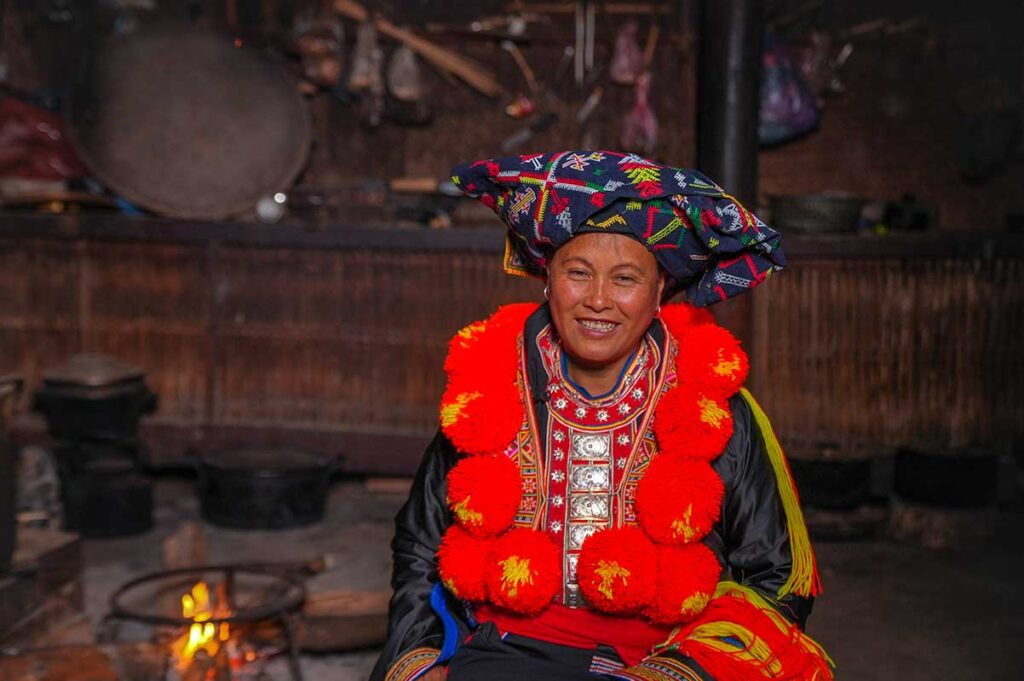
Na Hang is home to more than a dozen ethnic groups, including the Tày, Dao, H’mong, and others. While not every village is open to tourism, you’ll still encounter elements of local life through traditional stilt houses, colorful woven textiles, and unique dishes made from forest vegetables, fermented ingredients, and grilled river fish.
If you’re lucky enough to visit during a festival or harvest season, you may witness Then singing, Sli melodies, or the Red Dao fire dance — all important parts of local identity. To get a closer look at village life, homestays in areas like Hong Thai or Lam Binh offer a chance to stay in a wooden house, join family meals, and taste homemade corn wine. Just be aware that English is rarely spoken, so you may want to prepare a few phrases or use a translation app.
5. Kayak on Na Hang Lake
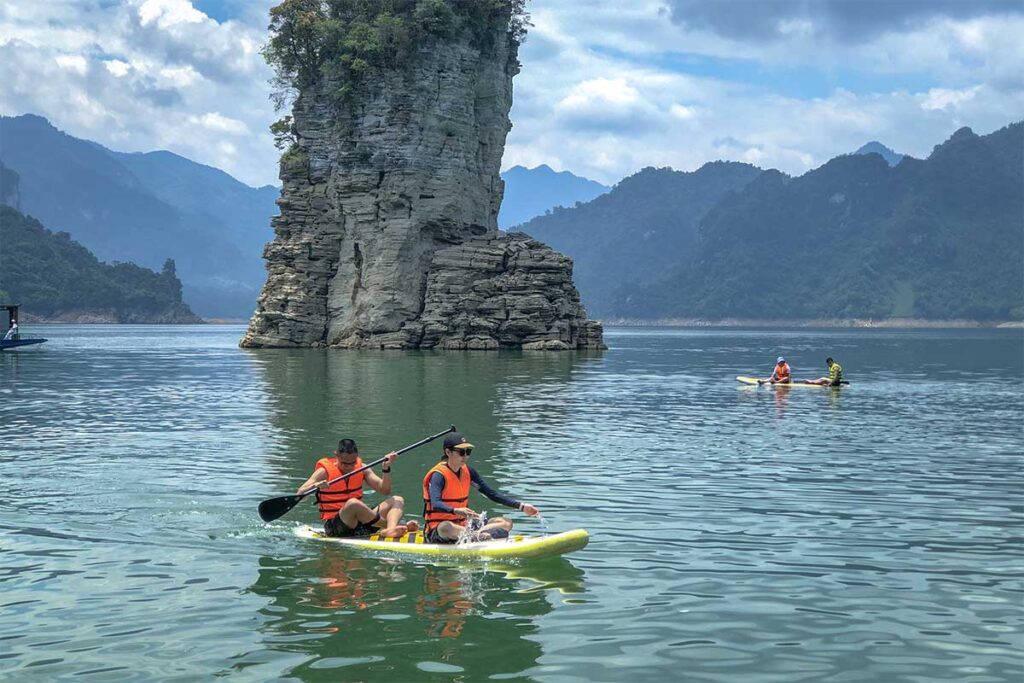
For travelers who want a more active experience than a boat ride, kayaking on Na Hang Lake is an excellent alternative. You can paddle at your own pace, explore the shoreline, and even pull up to small beaches or rocky inlets that larger boats can’t reach.
Kayak rentals are not available everywhere, but some tour operators and homestays in Lam Binh or Na Hang town can arrange them on request. Most kayaks are rented by the hour or half-day, with prices ranging from 100,000–200,000 VND/hour (about $4–8 USD). It’s best done during the dry season when the lake is calm and visibility is at its best.
6. Visit Pac Ta Temple
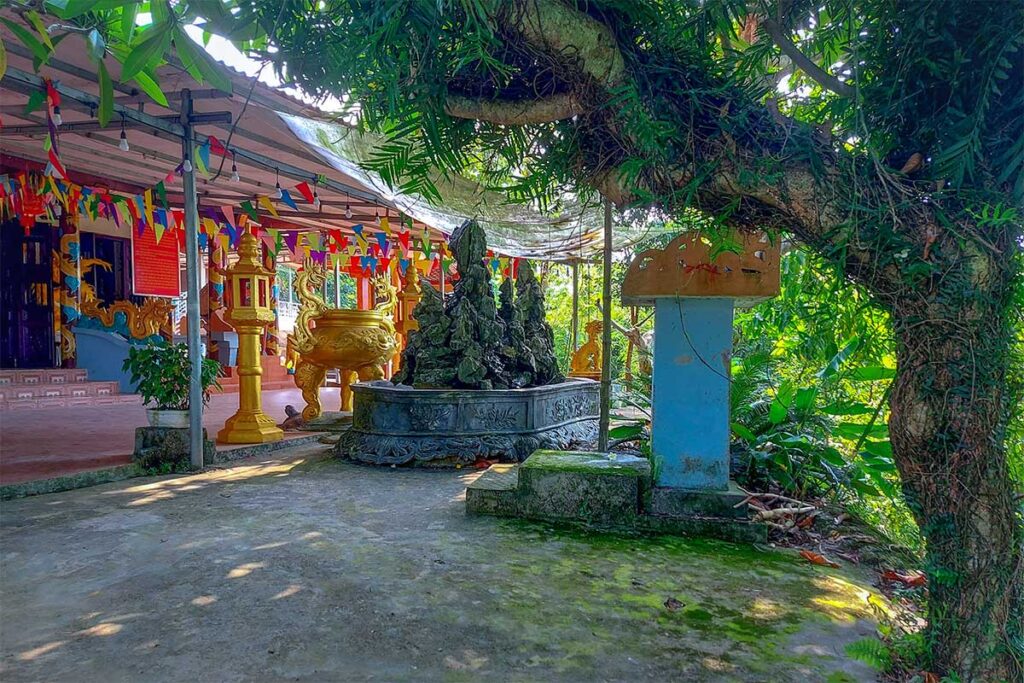
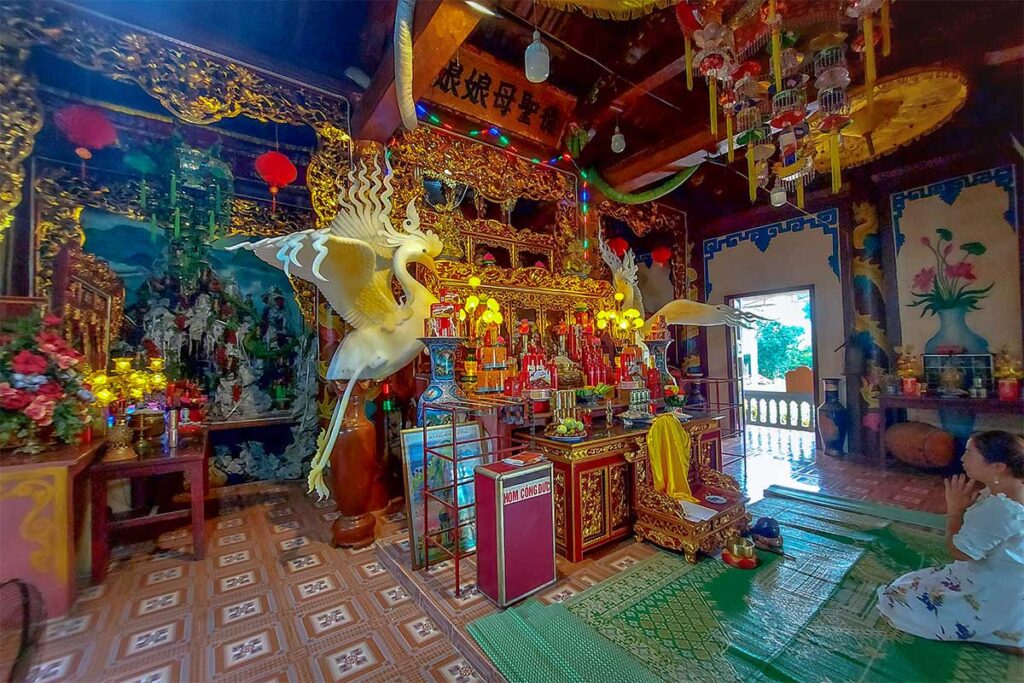
Pac Ta Temple sits at the foot of Pac Ta Mountain, where the Gâm and Năng rivers meet — a spot considered sacred for centuries. The temple is dedicated to the fiancée of General Trần Nhật Duật, who, according to legend, drowned on the way to their wedding. Locals later built the temple in her memory, and today it’s one of the most important cultural and spiritual landmarks in the region.
You can reach the temple by boat from Na Hang wharf, often as part of a standard lake tour. The temple itself is modest but beautifully located, backed by mountains and facing the water. If you’re visiting around Lunar New Year or early spring, you may see locals attending ceremonies or praying for good weather and harvests.
7. Stay overnight: Camping or local homestays
For an authentic experience, spending the night in Na Hang is a must. You have two main options: camping by the lake or staying in a local homestay.
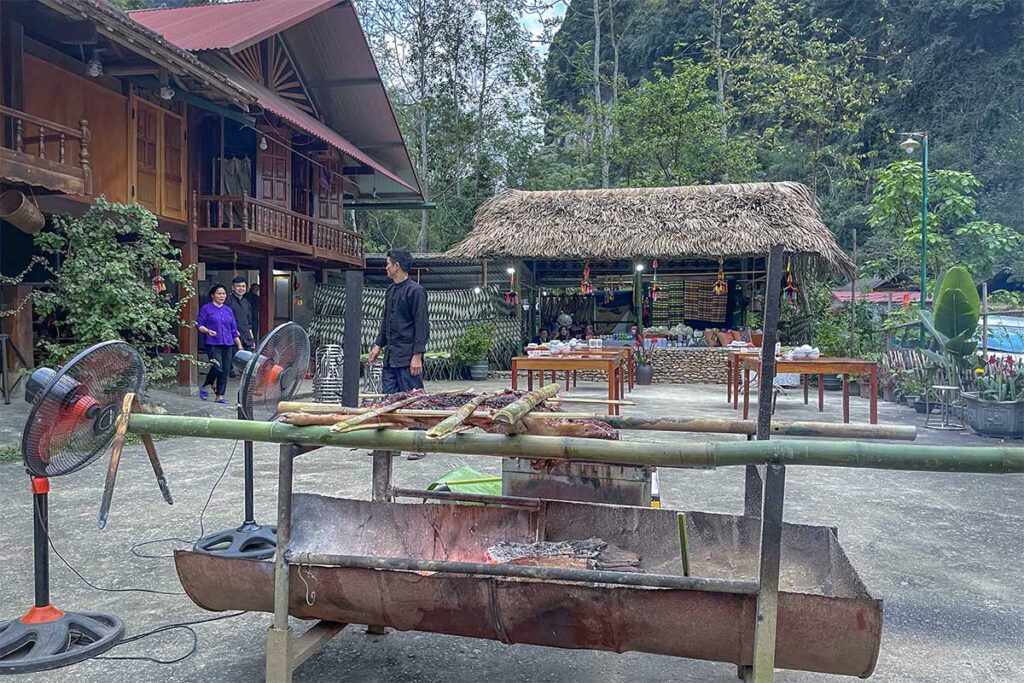
Camping is popular with Vietnamese travelers, especially on weekends. There are designated lakeside spots, and locals often bring food and barbecue supplies. If you’re interested in camping, it’s best to coordinate with a local guide, hotel, or boat operator to find a safe, legal area to pitch your tent.
Homestays, on the other hand, offer a deeper connection with local life. Most are Tày or Dao family-run wooden stilt houses, with basic but welcoming accommodation, home-cooked meals, and the chance to see how people live in the highlands. You’ll find good options in Na Hang town, Lam Binh, and Hong Thai. Just expect limited English and simple facilities — this is more about the cultural experience than luxury.
8. Nature hikes in Tat Ke – Ban Bung Nature Reserve
Tát Kẻ – Bản Bung is a vast nature reserve covering over 30,000 hectares of limestone mountains and forest. It’s home to endangered wildlife like the Tonkin snub-nosed monkey, hundreds of bird species, ancient trees, and rich biodiversity — but it’s not suitable for unguided trekking.
If you want to explore it, the best option is to join a guided tour arranged through a local tourism office or homestay. These hikes often include waterfall stops, jungle trails, and storytelling from forest rangers or local guides. Expect steep and sometimes slippery terrain, so come prepared with proper shoes, insect repellent, and drinking water. There are no marked paths or visitor centers, so going alone is strongly discouraged.
9. Take a cool dip at Mo Waterfall
If you’re short on time or not up for a hike, Mo Waterfall (also called Pác Ban) is an easy and worthwhile stop. Located just 2 km from Na Hang town, it’s directly accessible from the road and is often included in short boat trips or day tours.
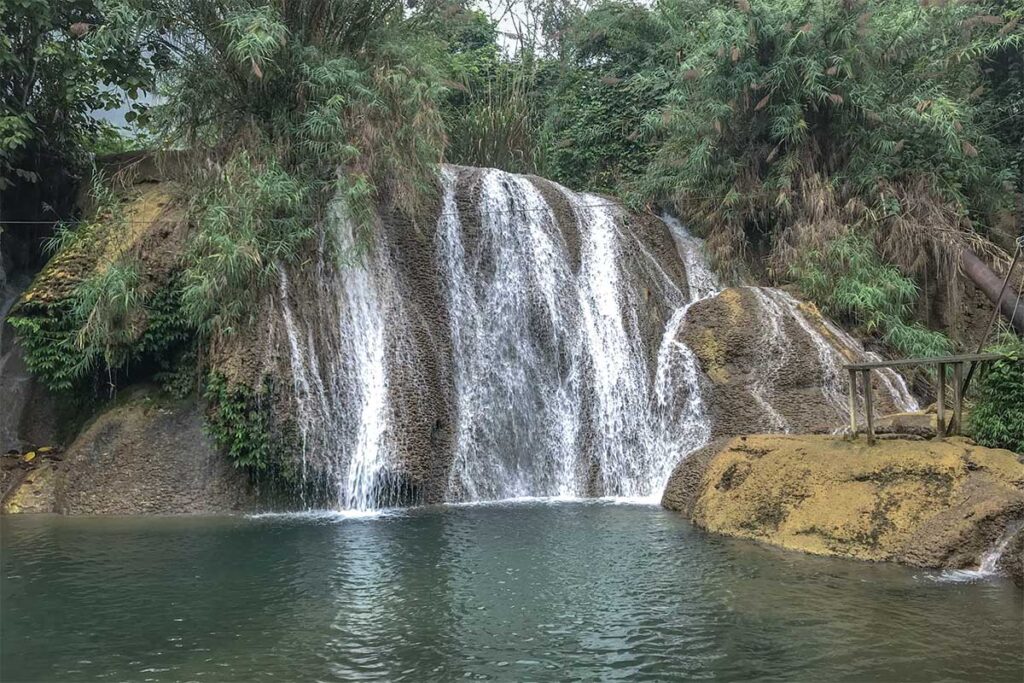
The waterfall has multiple tiers and a dramatic drop from the cliffs above, especially during the rainy season. The lower pools are safe to dip into, and there are floating restaurants nearby where you can try local dishes while enjoying the view. It’s also a popular stop for families, with easy access and shaded areas to relax. Entrance is usually free, but you may be asked to pay a small local park fee (about 40,000 VND) depending on the season and access point.
10. Taste Na Hang’s Local Specialties
Food is a big part of the Na Hang experience, especially if you’re staying with a local family. Many ingredients come straight from the forests and rivers — expect fresh, seasonal, and often foraged dishes.
Top local specialties include:
- Grilled river fish from the Gâm River
- Gỏi cá bỗng (a raw fish salad made from cá bỗng, a prized river fish)
- Thịt trâu gác bếp (smoked buffalo meat)
- Xôi ngũ sắc (five-colored sticky rice)
- Cơm lam (bamboo-cooked sticky rice)
- Corn wine brewed from wild herbs
Some of these dishes are best enjoyed at homestays or local eateries, where they’re made in the traditional way. Outside of Na Hang town, expect limited menus and mostly local food — so it’s good to try a bit of everything.
How to get to Na Hang
Location
Na Hang is located in Tuyên Quang province, in the northeast of Vietnam. It lies about 250 kilometers north of Hanoi and borders remote regions of Cao Bang, Bac Kan, and Ha Giang provinces. Despite its growing popularity among Vietnamese travelers, Na Hang remains very remote and is not a town with a large tourism infrastructure.
There are no airports or train stations, and connections are only by road. Direct public transport options are limited, and many travelers reach Na Hang as part of a longer overland trip or with private transportation.
Direct bus from Hanoi to Na Hang
There is currently one main bus company with multiple daily departures from My Dinh Bus Station in Hanoi that stops in Na Hang. These long-distance buses usually continue on to Cao Bang or even Meo Vac (Ha Giang), but you can get off at Na Hang town along the way.
The ride to Na Hang takes about 6 hours, and while the buses are basic, it’s the only direct public option if you’re not driving yourself. Tickets can usually be booked at the station or through local agents.
Buses from Hanoi to Tuyen Quang
Another option is to first travel from Hanoi to Tuyên Quang City, the capital of the province. This route is much better served, with frequent departures and limousine buses that cover the distance in around 3 hours.
From Tuyên Quang City, you’ll need to continue another 2.5 to 3 hours by road to reach Na Hang. This can be done by:
- Hiring a private car with driver
- Riding a rented motorbike
The second leg of the journey is scenic and passes through smaller towns, valleys, and rivers — a good opportunity to explore more of Tuyên Quang province along the way.
Also check: Best things to do in Tuyên Quang
Visiting Na Hang part of a broader north Vietnam trip
Instead of seeing Na Hang as an isolated destination, it’s also an ideal stop on a longer north Vietnam adventure — especially if you’re exploring eastern Ha Giang, western Cao Bang, or nearby Ba Be Lake in Bac Kan province.
Here are the best ways to connect Na Hang with other northern destinations:
- Private car with driver
The most comfortable option, especially if you’re traveling in a group or with family. You can stop anywhere you like along the way and connect Na Hang with other nearby highlights like Ba Be Lake, Bao Lac, or Lam Binh.
Book a car and explore Na Hang with ease
We can arrange a car with driver from Hanoi or other provinces and help link Na Hang with stops like Ba Be Lake, Bao Lac, or Lam Binh as part of a custom northern Vietnam route.
- Renting a motorbike
Ideal for flexible, adventurous travelers. Round trips from Hanoi are easy to arrange, but one-way rentals are harder in this remote area. If you want to do a loop including Na Hang, Ha Giang, and Cao Bang, plan to return the motorbike to your starting point.
- Easy Rider (motorbike with driver)
If you’re not comfortable riding a motorbike yourself, Easy Rider guides can take you as a passenger on the back. This is a popular way to explore the highlands without worrying about navigation or road safety.
Accommodations in Na Hang
Don’t expect luxury in Na Hang — accommodation is basic, but it does the job. You’ll find two main types of places to stay: simple hotels in town and rustic homestays in the countryside.
Hotels in Na Hang Town
Hotels in Na Hang town are mostly small guesthouses or local hotels. Rooms are clean but basic, with just the essentials. They’re convenient for late arrivals or if you want private space, but don’t expect charm or atmosphere.
Homestays in the countryside
Homestays in nearby villages like Lam Binh or Hong Thai offer a much more local experience — wooden stilt houses, shared meals, and beautiful natural settings. Facilities can be very simple (shared bathrooms, thin mattresses), though some newer places offer more comfort, and even pools.
If you want nature, quiet, and a cultural connection, go for a homestay. If you want convenience and a quick overnight stay, the town hotels are fine.
Book ahead, especially on weekends or during local holidays. Many places aren’t listed on big platforms, so booking may require some help or local contacts.
Best time to visit Na Hang
Best time: Spring and Autumn
The best times to visit Na Hang are spring (February to April) and autumn (September to November). These seasons offer the most pleasant weather — warm during the day, cool at night, and with clearer skies for enjoying boat trips, mountain views, and village walks.
Most beautiful time: Summer
That said, the rainy season (May to August) also has its advantages. This is when nature is at its most vibrant — rice terraces in places like Hong Thai are bright green, and waterfalls like Khuoi Nhi and Mo are full and flowing. Just be prepared for afternoon showers, high humidity, and muddy paths if you’re doing outdoor activities.
Cool and dry season: Winter
Winter (December to January) is the dry season. While the landscape may look a bit drier, it’s still a great time to visit — especially for photography or trekking. Daytime temperatures are often mild with clear skies, but nights can get cold, especially in the hills. Most accommodations don’t have heating, so bring warm layers if you’re staying overnight.
Travel tips for visiting Na Hang
Bring enough cash
ATMs are scarce and international cards may not work. Most payments — including homestays, meals, and boat rides — are cash-only.
Buy a Vietnamese SIM card
Mobile coverage in Na Hang is decent, even in remote areas. A local SIM with data is essential for navigation, translation, and communication. You can get one easily in Hanoi or Tuyên Quang before heading north.
Download offline maps and translations
Network coverage can drop in more remote areas. Download Google Maps offline for the region and consider using offline translation tools or saving key phrases in Vietnamese.
Expect limited English
Few people speak English in Na Hang, including at hotels and tourist spots. Translation apps like Google Translate or ChatGPT are incredibly useful here.
Plan your transport in advance
This is a remote destination with limited connections. Buses, private cars, or motorbike hires should be arranged ahead of time.
Dress for changing weather
Even in warmer seasons, mornings and evenings can be cool — especially near the lake or at higher altitudes like Hong Thai. Winter nights can get cold, and heating is rare in most accommodations.
Bring swimwear and water shoes
Waterfalls like Khuoi Nhi and Mo are great for a refreshing swim — and sturdy water shoes help on slippery rocks.
Combine with other destinations
Na Hang connects well with several other scenic regions in northern Vietnam. You can combine it with:
- Ba Be Lake (Bac Kan): Just a few hours west, Vietnam’s largest natural lake is great for boat trips, caves, and homestays.
- Ha Giang: From Na Hang, you can head northeast to join the Ha Giang Loop, especially starting from Bao Lac.
- Cao Bang: If you’re going east, you can reach the western side of Cao Bang province, and from there, explore highlights like Ban Gioc Waterfall.
These routes are best done by motorbike, Easy Rider (motorbike with driver), or private car, as public transport between these remote areas is very limited.
